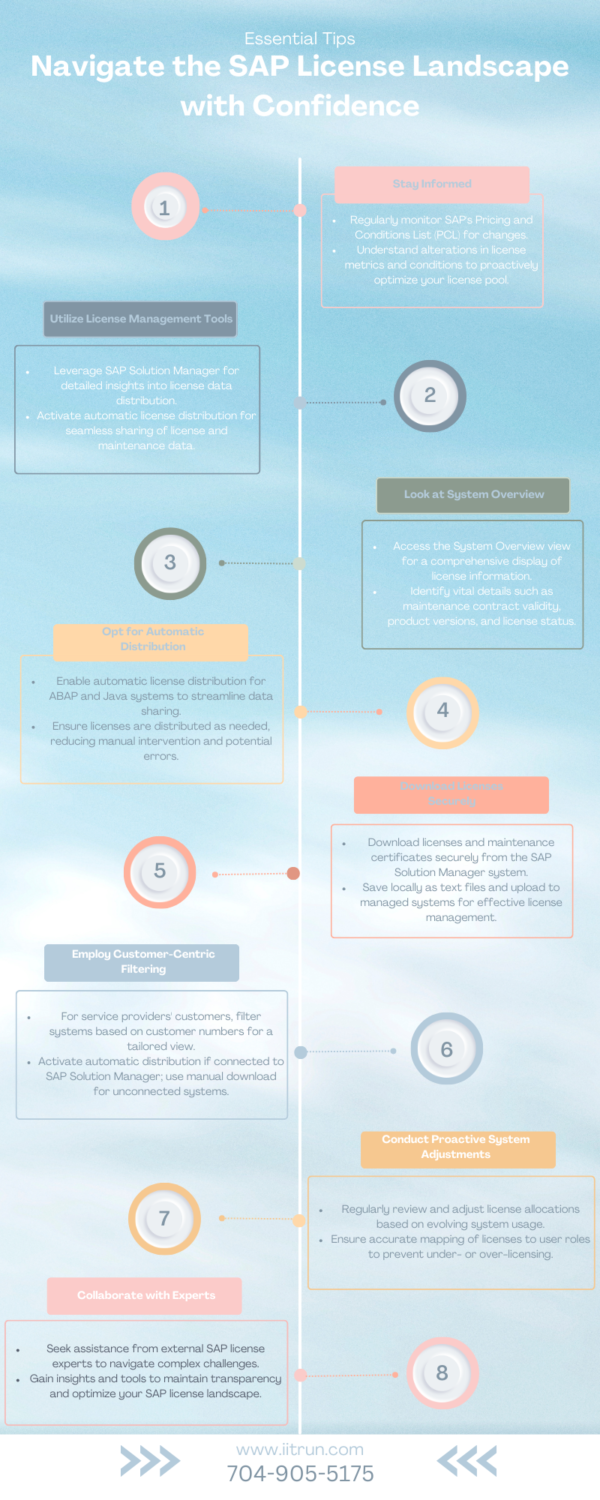
Overall, SAP license management plays a pivotal role in ensuring organizations can adeptly monitor and manage their SAP software licenses. When done properly, it contributes to cost control, compliance, and the efficient allocation of resources within an organization. On the other hand, SAP license management often poses challenges for businesses. If not done properly, businesses can struggle with operations, compliance, costs, and other aspects.
This process involves a comprehensive approach, including the tracking of license status, quantity, and expiration dates. Additionally, the organization needs to efficiently distribute licenses among employees and different business units. Primarily, businesses need to maintain compliance with SAP regulations, ensuring that organizations avoid any issues related to improper licensing.
The features of this process include accessing information about license data distribution, conducting validity checks on existing licenses, and deciding on the automatic distribution of licenses and maintenance certificates from platforms such as the SAP Solution Manager system. Let’s dive into the common challenges and a few solutions to learn more!
Common Challenges with SAP License Management
SAP license management presents several common challenges that organizations must navigate to ensure optimal software utilization. For instance, over-licensing often arises due to insufficient visibility into software usage, leading organizations to procure more licenses than necessary. Additionally, inefficient license tracking mechanisms and unclear user classifications may contribute to this issue. Over-licensing burdens the business as it strains budgets and diverts funds from critical areas.
Conversely, under-licensing poses risks such as operational disruptions and decreased productivity. In this scenario, organizations fail to procure sufficient licenses to cover actual software usage. Legal implications, including fines and penalties, may arise from non-compliance with SAP licensing agreements.
Another significant challenge is the presence of complex license structures within SAP. In particular, organizations grapple with multi-tiered licensing models and the intricate task of understanding user types and access levels. As they struggle to navigate these structures, businesses often face misalignment. To avoid inefficiencies and license accurately, businesses need to clearly define user types and access levels.
Strategies for Effective SAP License Management
In addressing these challenges, organizations can adopt various strategies for effective SAP license management. In any case, businesses must conduct regular internal audits, undergoing periodic reviews of software usage against purchased licenses. With a robust auditing process and license management tools, businesses can accurately track their licenses. Equally important, businesses should prepare for external audits, encompassing activities such as maintaining up-to-date license records and engaging legal and compliance teams in readiness efforts.
To optimize license allocation, businesses need to identify and address unused licenses through regular reviews of user activity and the implementation of automated tools for identification. Role-based access control (RBAC) is a key strategy, ensuring that users have access rights aligned with their roles and responsibilities. Additionally, regularly updating and reviewing access control policies further enhances optimization.
Negotiating effectively with SAP is another critical aspect of license management. To understand negotiation leverage, businesses need detailed knowledge of current and future software requirements, awareness of SAP’s licensing policies and pricing structures, and demonstrated compliance with existing agreements. A successful negotiation requires strong relationships with SAP representatives, flexible licensing models, and a search for discounts or incentives based on long-term commitments and usage patterns.
In addition to these strategies, organizations should explore the uses and applications of specific SAP license management tools and solutions. These tools offer an overview of license management software, highlighting their benefits and features. Choosing the right tool for an organization involves considering factors such as its specific needs, scale, and budget.
Fortunately, SAP provides a license management software to easily view, access, and control licenses.1 Through their tools, businesses can review the distribution of license data, including licenses and maintenance certificates. This allows you to assess the validity of existing licenses and certificates in your managed systems and track the status of new ones.
The software includes status indicators: red for expired, yellow for expiration within 30 days, green for valid licenses, and gray for no data available. Businesses can also navigate detailed information about individual systems, their license data, and log messages.
To share data, businesses can automatically distribute license and maintenance certificates. In cases where they need to distribute manually, they can download licenses and maintenance certificates.
Ultimately, some best practices for effective SAP license management involve regular tracking, documentation, and monitoring of licenses. Additionally, businesses should ensure compliance with End User License Agreements (EULA), conduct audits to align active users with purchased licenses, optimize SAP license usage and costs, and ensure legal use for compliance and penalty avoidance.
View the following infographic for some more tips!

1 “License Management.” https://help.sap.com/docs/SAP_Solution_Manager/4f543d0dbc6647b794563e1f5e3dda1d/4142b6397c604278b6626f3d570c98c8.html





